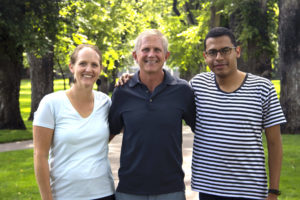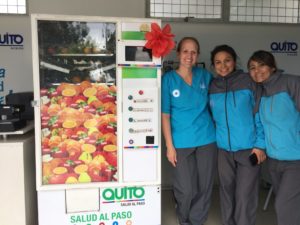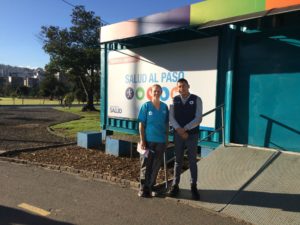
In 2015, Chris Melby embarked on a Fulbright Fellowship to Ecuador to study how changes in dietary patterns are related to the increasing rates of cardiometabolic diseases such as type 2 diabetes and heart disease. Melby, a professor in the Colorado State University Department of Food Science and Human Nutrition, established an ongoing, fruitful research collaboration with colleagues in the School of Public Health at the Universidad San Francisco de Quito. Melby’s Fulbright has led to several visits and connections among students and faculty from CSU and USFQ.
Melby is also a faculty member in the Colorado School of Public Health, a collaboration among Colorado State University, the University of Colorado, and the University of Northern Colorado. One of Melby’s graduate research assistants, Jenni Averett, a student in the Master of Public Health program, has worked on his research project in Ecuador and traveled there twice, once last January to launch a research project, and also with her family last May to complete a required practicum for her degree. Fadya Orozco, director of the master’s program in public health at USFQ, helped Averett work out details and objectives for her practicum while here at CSU in March.
“I love speaking Spanish, had been to Ecuador before, and wanted to learn more about the research process, so that’s why I applied for the initial GRA with Dr. Melby,” said Averett.
Practicum in Ecuador
While in Ecuador completing her practicum, Averett shadowed José Julio Villalba, a student and nutrition educator, on an outreach program called Salud al Paso, a chronic disease screening and disease prevention intervention program sponsored by the Quito Department of Health. Most of the MPH students in Ecuador are already working as full-time health professionals; those in the U.S. are mostly full-time students.

Villalba came to CSU in September to visit the Department of Food Science and Human Nutrition, where he sat in on some public health and nutrition courses, visited with faculty and students, and engaged in discussions about public health issues in the U.S. and in Ecuador. He also visited the Food Bank for Larimer County, The Growing Project, and the Fort Collins Rescue Mission.
“I learned a lot about classroom dynamics here,” said Villalba. “There is more discussion and debate with classmates. I also had the goal to improve my English on this visit.”
Large-scale nutrition intervention
Salud al Paso, or “Health on the Go” in English, is a large-scale nutrition education and intervention program to address nutrition transition in Ecuador. “Nutrition transition” refers to the shift in diet in developing countries from the more traditional, grain-based fare and vegetables high in fiber to a more Western-style diet high in sugar and fat. While in Ecuador, Averett was able to accompany Villalba to management-level meetings and learn how they were coordinating their staff, as well as visit the sites where they were doing the nutrition screenings and interventions.
“Jenni was able to meet my colleagues in Ecuador and compare how they do nutrition counseling in our two countries,” said Villalba.

“The program takes place in shipping containers that are brightly painted and placed in the main parks and transit centers, where people already are on their regular routes so they can conveniently stop in to get their screening done,” said Averett.
The scope of the program is huge, encompassing about 20% of the population of Quito. Villalba oversees 80 nutritionists who are conducting the nutrition screenings, and research for his thesis involves assessing the program through analyzing that data.
“We had the opportunity to work for four years and have lots of data,” said Villalba. “We’ve screened over 500,000 people and have 168 variables including demographic data, as well as physiological data like blood pressure, weight, and glucose levels. Sixty percent of those in the study are obese or overweight, so I’m trying to find out how we can change this and also reduce blood pressure and waist circumference.”
Villalba is looking at both quantitative and qualitative data, asking about how peoples’ behavior changed and what motivated them to make those changes.
“I learned a lot from the experience and José was wonderful to host me for five weeks,” said Averett.
New research on dietary diversity
In addition to facilitating student and faculty exchanges, Melby, with the help of Averett, Orozco, and his partners in Quito, has continued his research in Ecuador. Melby’s first study looked at urban and rural differences in the nutrition transition, asking how the dietary patterns differed between rural and urban areas.
Thanks to a grant from Colorado School of Public Health, Melby has collected additional data looking at dietary diversity in families in the Imbabura region of Ecuador, which is above 9,000 feet, influencing what they can grow. On one of Averett’s trips to Ecuador, she was instrumental in helping train the research assistants to go out to the different areas to interview maternal heads of households about their agricultural practices.

The team, which also included Professors Maria Jose Romero and Amparito Barahona from the Universidad Tecnica del Norte, was able to use GIS mapping to identify where agricultural diversity was taking place, based on the number of crops that are grown in the garden plots of these families in rural areas of the Andes.
“We are trying to determine whether or not the families who have more agricultural diversity in terms of the number of crops they grow, also have better dietary diversity which puts them at lower risk for food insecurity and malnutrition,” said Melby.
“Dietary diversity,” or eating a variety of foods, is a common public health recommendation to avoid chronic diseases. Not eating a variety of foods can result in nutritional deficiencies that can lead to poor health.
Melby and Averett, who is also doing her capstone project and an independent study with Melby, are currently analyzing their data, trying to understand why some families have more dietary diversity than others. It could be that some are selling more of their crops, rather than consuming them.
“It’s a bit of a double-edged sword,” said Melby. “There is less dietary diversity in the rural areas and less risk for chronic diseases, but more risk for malnutrition. Some urban areas have more dietary diversity, but also have access to higher fat and higher sugar, commercially prepared foods, which can lead to higher rates of obesity.”
In terms of the ultimate impact for the study, Melby said he would like to develop opportunities and approaches in partnership with his Ecuadorian colleagues, based on active participation in the communities, which could increase dietary diversity with a lower risk for malnutrition. “The key is to select a diet not so high in fat and sugar,” he added.
“The goal would be lowering the incidence of chronic diseases among people in Ecuador which have been skyrocketing so rapidly, and maximizing dietary diversity to minimize risk for malnutrition while simultaneously minimizing the negative impacts of the nutrition transition,” Melby said.
The Department of Food Science and Human Nutrition is part of CSU’s College of Health and Human Sciences.